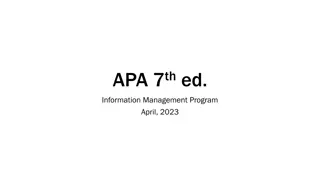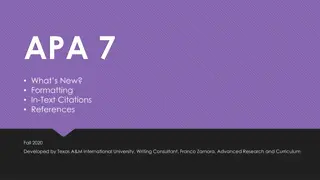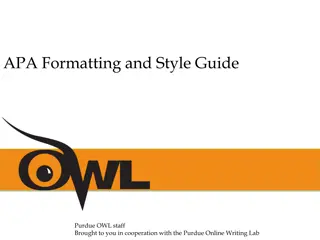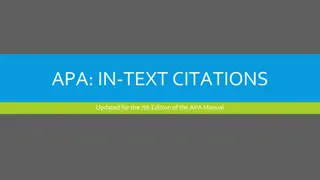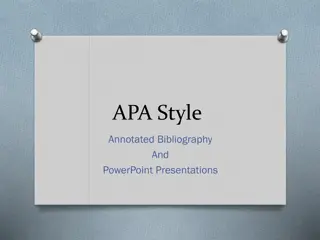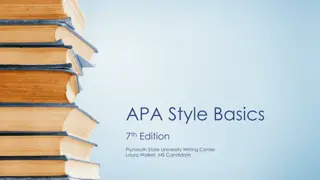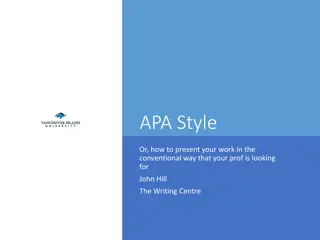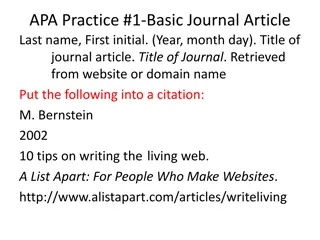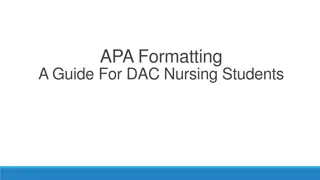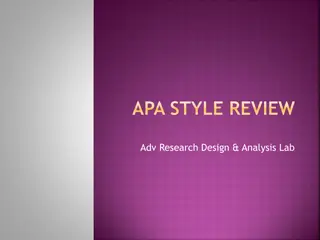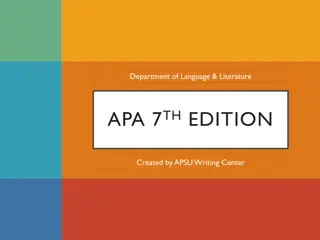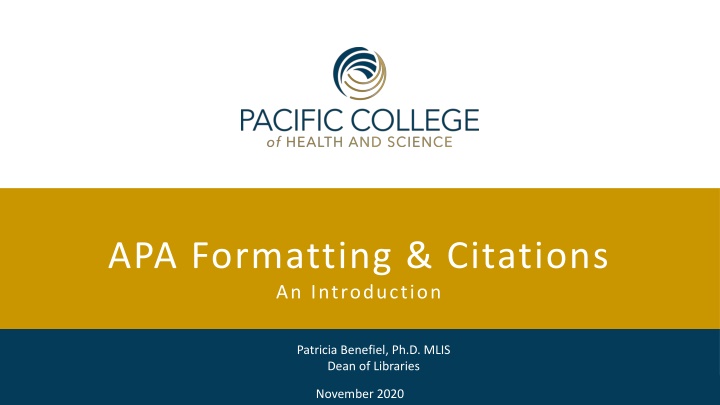
Guide to APA Formatting and Citations: Learn How to Cite, Paraphrase, and Format Your Paper
Explore the fundamentals of APA formatting and citations with insights on what to cite, how to paraphrase effectively, types of citations, and citation formats for references. Learn the essentials of in-text citations, proper formatting in APA style, and where to find examples. Enhance your understanding of citing sources accurately and avoid plagiarism.
Download Presentation

Please find below an Image/Link to download the presentation.
The content on the website is provided AS IS for your information and personal use only. It may not be sold, licensed, or shared on other websites without obtaining consent from the author. If you encounter any issues during the download, it is possible that the publisher has removed the file from their server.
You are allowed to download the files provided on this website for personal or commercial use, subject to the condition that they are used lawfully. All files are the property of their respective owners.
The content on the website is provided AS IS for your information and personal use only. It may not be sold, licensed, or shared on other websites without obtaining consent from the author.
E N D
Presentation Transcript
APA Formatting & Citations An Introduction Patricia Benefiel, Ph.D. MLIS Dean of Libraries November 2020
Heres what you will learn: 1. What you need to cite. 2. How to paraphrase. 3. The various types of citations. 4. The parts of a citation. 5. Where to find examples of citations. 6. Where to place citations. 7. Where to get citations. 8. How to format your paper in APA style. 2
How to paraphrase It is important to put what you read into your own words. You must change more than a few words or phrases. You cannot simply change the order of the words in a sentence. Staying too close to the original wording is still plagiarism, i.e., stealing another s words and ideas. Be careful not to use the original author s terms and phrases without quotation marks. It is still necessary to cite the source of the ideas that you have paraphrased. Original To the extent that a child is separated from its mother at an early age, a child may suffer generalized separation anxiety. (Heinz, 2009). Paraphrase When children are taken away from their mothers when they are very young, they are likely to be afraid to leave familiar people and places. (Heinz, 2009). 4
Types of Citations Citations come in two types: in-text and reference list In-text citations are very simple. For a paraphrase, use the author s last name and year of publication after the paraphrased term or section: Heidegger felt that the idea of being was not clearly understood. (Heidegger, 1927). For a direct quotation, add the page number as well: Being is not something like a being. (Heidegger, 1927, p.4). 5
Citation Formats for a Reference List Citations for your reference page vary according to the type of document. There are different formats for books, chapters of books, e-books, articles from print journals, articles from online journals with and without DOI (digital object identifier), quotation or paraphrase from a website, and more. All these formats are differentiated and presented with examples in a number of sources, online and in printed texts. The following slide shows an example of a reference format for a journal article. 6
Citation List Format (Image from https://apastyle.apa.org/style-grammar-guidelines/references/basic-principles) 7
Citation formats for Reference List All citations in a reference list must be double spaced. The second (and any further) line must have a hanging indent. For example: Material Type Reference List Citation Format Book in print Author, A. A. (Year of publication). Title of work: Capital letter also for subtitle. Publisher. Maciocia, G. (2015). The foundations of Chinese medicine: A comprehensive text (3rd ed.). Churchill Livingstone. 8
Where to find examples The Writing & Citing page on the Pacific College Library web page: https://www.pacificcollege.edu/resources/library/writing-citing The Publication Manual of the American Psychological Association (seventh edition) The APA Style website: https://www.apastyle.org/ The APA Formatting and Style Guide from the Purdue Owl Writing Lab: https://owl.purdue.edu/owl/research_and_citation/apa_style/apa_formatting_and _style_guide/general_format.html 9
Where to place citations Citations appear in two places in an academic work. In-text citations appear in the body of the paper at the end of a term, phrase, paragraph, or longer selection. In-text citations are brief. They consist of the author s last name and the date of the publication. If the citation refers to a direct quote, the page number(s) is added. You should have a reference list at the end of your paper. This is a list, arranged alphabetically by author s last name, of all the sources that you quoted or paraphrased in your paper. This is not the same as a bibliography, which is an alphabetical list of all the resources you found related to the topic of your paper, including those you did not use. An academic paper does not require a bibliography. 10
Where to get citations Most journal databases allow you to download citations or send them to your email. You can then paste the citation into the reference list in your paper. For example, in PubMed, there s a citation icon on the top right of the article page under the subtitle Formats. (See next slide). Click on that icon and you will see several choices of citation format. Choose the APA-style citation and copy and paste it into the reference list of your paper. In a linked full text document, the citation will often appear within the document, usually at the top of the first page or at the end of the document. For books, you will have to create your own citations. Always check copied citations for proper formatting. 11
How to get citations in PubMed https://www.ncbi.nlm.nih.gov/pmc/articles/PMC6167431/ 12
How to format your paper in APA style There is an excellent demonstration of formatting for APA style, complete with examples and links for more information, on PCOM Library s Writing & Citing page: https://www.pacificcollege.edu/resources/library/writing-citing However, Microsoft Word, for both pc and Mac, offers an APA style template. Open a new document in Word and scroll through the templates to find APA style report. The template includes instructions. For example: [Title Here, up to 12 Words, on One to Two Lines]. Just type your information in place of the instructions. 13
APA7 Formatting When you are ready to write your paper and need to put it into a formal APA format, there are certain steps to take that ensures you have everything in order. The easiest step before you begin typing is to make sure that the document is double spaced. Font: APA now allows other fonts besides Times New Roman 12. It recommends 11-point Calibri, 11-point Arial, 10-point Lucida Sans Unicode, 12-point Times New Roman, 11-point Georgia, or 10-point Computer Modern. Cover Page: "Running Head" is no longer used in the header of APA papers. For student papers, APA now says only the page number is needed in the right hand corner of the header. Titles: Your paper's title on the cover page and first page is now Bold, and written in Title Case. So are most section headings. (from Berkeley College Website -https://chat.library.berkeleycollege.edu/faq/285800) 14
MS Word APA Template Berkeley College Website -https://chat.library.berkeleycollege.edu/faq/285800 15
Any Questions? Check citation format in the APA Publication Manual. Every possibility that you can imagine is covered in this book. Browse the PCOM Library Writing & Citing page: https://www.pacificcollege.edu/resources/library/writing-citing Ask a librarian: Pat Benefiel (San Diego) pbenefiel@pacificcollege.edu Janet Harper (Chicago) jharper@pacificcollege.edu Raquel Fereres (New York) rfereres@pacificcollege.edu 16

